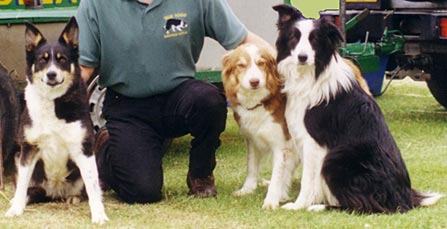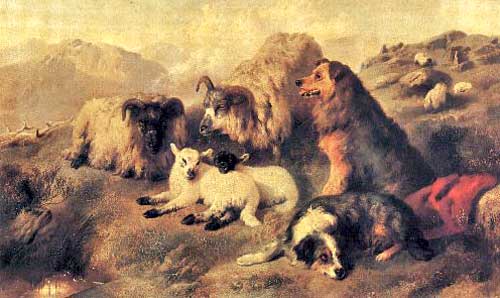

![]()
LOOKS AND DIVERSITY IN THE BORDER COLLIE

Three Border Collies belonging to Bob Hogg of Witney, Oxfordshire, England.
Bob and his dogs travel around the country giving herding demonstrations at shows and festivals.
It is incorrect to state that shepherd[']s [dogs] have been bred solely for work[ing] ability with no care for looks or conformation. Seldom does one see an ugly working collie, and even more seldom, one of poor conformation. Hard working farm dogs would never cope with years of stock work if they were ill-made.
...[S]howing has not developed these beautiful dogs; they are the product of many, many years of careful breeding by practical shepherds, most of whom have carefully studied the pedigrees of the animals involved...Show enthusiasts are now reaping the benefit of all this past experience...
The renowned quality of the Border Collie must continue to be judged on its work[ing] ability, as it has been judged for over 100 years...not solely on its good looks, or by its show ring successes...
The Border Collie has achieved the high esteem in which it is held, by sheer merit of accomplishing its herding tasks to the highest standards in the pastoral...world.
--Mrs. E. B. (Barbara) Carpenter
Brocken Border Collies
Pasters Hill House, Gloucestershire
April 1986
Because Border Collies are bred for intelligence and working ability and not just for looks, there is a great deal of diversity in appearance. They can have smooth (short) or rough (long) coats, or anything in between. The coat, even in smooth-coated dogs, is double with a longer, coarser outer coat, and a shorter softer undercoat which sheds out completely by summer, so that they definitely need grooming. A very long coat could be a hazard to a working dog. Coats may be straight to curly--this is not a standard, but a fact. The Border Collie also comes in a remarkable variety of colors.
Please note: the following pages are here to demonstrate the great diversity of this breed. This diversity in the Border Collie has come about precisely because the Border Collie has not been bred specifically for looks. Other breeds of dog show much less diversity, from exhibiting only a single color to exhibiting only a few variations in color and pattern. Even other herding breeds suffer from this type of selection. That there are pages on looks in the Border Collie Museum should not be taken as meaning that we encourage breeding for looks. On the contrary, we hope to point out that the more a breed is bred for looks the fewer the possibilities and the narrower the diversity.
OUR POLICY ON ACCEPTING PHOTOGRAPHS OF DOGS
I am grateful and beholden to Border Collie owners who send me photographs of their beautiful dogs. However, these pages are enormously large, for which there is a cost associated in both time and money (space costs). Given the immensity of the task of going though all the photos I am sent, selecting photos for use on the website, and preparing these photos for the web, many photos have lingered in abeyance for much longer than they should have, for which I apologize.
However, I must reiterate that these pages are to demonstrate the diversity of the breed, and are not meant just as a space to exhibit beautiful dogs. I have been asked many times by myriad people to post photos of their dog on my website, so just let me clarify:
1. Only those dogs that best represent particular colors or patterns will be used. Dogs that represent an unusual example of a particular color or pattern will be given priority because I probably already have myriad examples of the more usual types. If possible, I will be rotating photos, so if you see your dog today, you may not see him or her in a month or two; and if you don't see your dog, stay tuned, you might see yours in the future. Please don't ask me why your dog's not there.
2. Only good photographs will be accepted. Yes, I get to decide what's a good photograph. One that takes a lot of fidling with to make it good is not good. And photos for the web are by definition of lower quality than photos for printing, so the photo has to start out being of very high quality. I will probably only use one photograph of any given dog, but it would be best to send several so that I may chose.
3. I answer every email sent to me, so if you don't hear from me, please assume that for some reason I didn't get your email. Maybe it was just too big. To be on the safe side, attach each photo you are sending to a separate email.
[Please click on the pictures to get to a page.]
 BLACK-AND-TAN |
 BLACK-AND-WHITE |
 BLUE |
 BRINDLE |
 LILAC |
 MERLE |
 PATTERNED WHITE & COLOR-HEADED WHITE |
 RED (CHOCOLATE /BROWN) |
 SABLE |
 SADDLE PATTERNED |
 SPLIT FACE (HALF-WHITE FACE) & ALL-WHITE FACE |
 TAN (AUSTRALIAN RED) |
 TICKED |
 TRICOLOR & BLACK-AND-TAN |
 COAT TYPE |
 EYE COLOR |
 EARS |
 FOCUS |
Black (black-and-white) is the most common color for Border Collies and often preferred by shepherds, along with tri-color (black, white and tan). Red (red-and-white, and also red-tri (red, white and tan)) is not uncommon. Red in a Border Collie (which is called chocolate in Australia), is actually liver or brown (as in the Springer Spaniel). Saddle-patterned (a variant of tricolor), and Blue (or grey) is less common, as is blue merle, red merle, sable, and tan. Black-and-tan in the Border Collie almost always has some small amount of white, and therefore can be considered tri-colored. It is an "old fashioned" color and was seen more in the past than it is today. All of these colors usually come with varying amounts of white, the traditional "collie markings": usually a white blaze on the face of varying widths, a white collar, white feet, chest and tail tip. Breeds like the Australian Shepherd, come in "self colors" or solids, but solid is very rare in the Border Collie. Some dogs are speckled or ticked. These dogs are usually born with their white areas completely white and as they grow varying amounts of spots begin to appear in the white areas. Ticking can come in all colors--black and white dogs will have black ticking, red and white dogs will have red ticking, etc. Sometimes the tan that runs into the white areas form ticking as well. Some Border Collies are born all white with small amounts of black, often on the ears, and their white areas will remain white all their lives. These dogs are often referred to as "patterned whites", but can also be solid white with a colored head or "colored-headed white". Half-white faces or all-white faces with just black ears, are also common. Brindle and Lilac are rare, but both are becoming less so. One color that I have yet to include is "seal", because it is very rare and I don't fully understand it yet.

"Guardians of the Flock" by George Horlor
shows two Border Collie-type dogs.
The one in front appears to be a blue merle tricolored dog,
the one behind a saddle-patterned sable.
We will not go into the actual genetics of color here, but if you are interested in canine genetics, visit Sue Ann Bowling's excellent website, "Animal Genetics". She covers basic genetics, and has many articles on color genetics with photographic examples, particularly pertaining to the Shetland Sheepdog, but which could be applied to the Border Collie as well. The colors mentioned above, are the same as may be found in other breeds of dog, but every breed seems to have different nomenclature for the same colors, and of course the particular genes for producing a particular color may not be present in a breed due to selection, which is why some breeds come in only one or two colors, while the Border Collie comes in such a variety of colors in different combinations. These colors, if indeed they ever existed in other breeds, have been bred out.
Wikipedia also has an excellent page on dog coats which explains the colors and the genetics thereof. It also has the genetics of coat type, length, etc.
With the mapping of the dog genome completed, there are possibilities for testing that we never dreamed of even ten years ago. Today, it is possible to test for color if you are uncertain as to what color your dog is, and it is even possible to test for the breeds present in a mixed breed dog. If you are interested in seeing what nomenclature is used for other breeds, or in seeing examples of color combinations that may also be possible in the Border Collie but we don't have examples of them (yet), we will continue to add links to websites that we think you will find interesting:
|
Sue Ann Bowling's website,
"Animal Genetics" |
"Coat and Colors of the Pembroke Welsh Corgi"
with photographic examples. (Unfortunately, this website is no longer up. If anyone has any information on where it has gone, please contact me at carole@woolgather.org.) |
Lisa McDonald's website "A Field Guide To Coloration of Australian Shepherds" has terrific photos of Australian Shepherds in just about all imagineable colors (and some that can't be imagined). This site has the most understandable explanation of how the genetics of each color works. |
"English Shepherd: |
Sharon Webley's website in the UK "Collie Corner" has outstanding photos of Border Collies in a large variety of colors. |
|
Liisa Sarakontu's website in Finnland "Canine Colors" has photos of Finnish Lapphunds in a large variety of colors illustrating the actual genetics of the colors. |
The North American Australian Kelpie Registry (NAAKR) has a webpage on Kelpie colors "Working Kelpie Colors and Description" with photos illustrating the accepted colors in the breed. |
Dr. Sheila Schmutz's website "Genetics of Coat Color and Type in Dogs" which she calls a "brief review" but for our purposes it is in depth. |
Bryning Border Collies, a breeding kennel of show dogs in the UK, has a web page on "Border Collie Colours" that includes basic genetics, and photos of dogs of the various colors, including seal. |
There is a Yahoo Group list for people interested in an ongoing discussion of color and color genetics in the herding breeds, with particular emphasis on the collie breeds. If you have an interest in such a narrow discussion topic:
THE OTHER WEB PAGES WE MAINTAIN
These web pages are copyright ©2014
and maintained by webmeistress Carole Presberg
with technical help from webwizard David Presberg
ALL RIGHTS RESERVED
If you are interested in using ANY material on this website, you MUST first ask for permission.